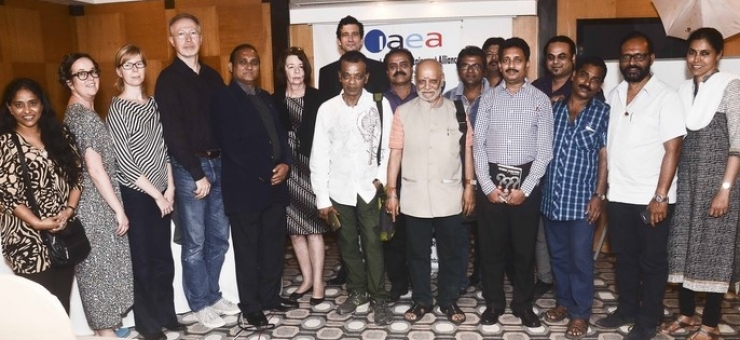Behind the scenes in Bollywood - working towards a healthy and safe work environment

The unions and associations of the Mumbai film industry came together last week to discuss health and safety in Bollywood. A seminar was organised on 26-27 November in Mumbai in the framework of a project funded by LO-TCO, with a view to discuss the working conditions in Bollywood and to look for ways for improving the situation.
Mumbai boasts one of the most prolific and popular industries in the entire world of entertainment: it is the Mecca of Indian cinema. Although several other film and television production hubs exist elsewhere in this vast country, Mumbai is the home of “Bollywood”, where glamorous and successful Hindi language films are made at a relentless pace. With millions living in poverty or stuck in the rat race, Bollywood is a formidable dream-selling machine.
Tens of studios compete with one another to produce the next box office hit, feature films but increasingly also television series and soaps, or sign lucrative deals with overseas productions seeking to shoot on location. Exposure to the international market has brought in more capital as more foreign studios and broadcasters spend their dollars in Mumbai to secure themselves a share of a 1.2-billion potential audience bonanza.
With hundreds of TV channels and sprawling multiplexes, content demand has never been greater and hardly a day goes by in Mumbai without crews hustling around, stunts pulling spectacular numbers, dancers engaging with tightly choreographed moves and actors delivering compelling stories on camera. And yet, behind Bollywood’s glamour, lies a much bleaker reality. A study commissioned by UNI MEI together with sister organisations FIM and FIA tells of abysmal standards exposing many film workers in Mumbai to unnecessary risks, often with troubling consequences.
Gruelling shifts, inadequate turnaround on many film sets, scant personal protection equipment for technical crews, no emergency procedures or fire safety measures, unsanitary conditions, and insufficient training are commonplace. Permanent injuries and casualties regularly occur and are muttered away with a striking sense of fatalism. If a handful of film studios are beginning to take health and safety requirements more seriously, television channels are lagging shockingly behind.
The flip side of Bollywood tells untold stories of actors fainting from exhaustion, stunt performers plunging to their deaths, gaffers getting electrocuted, voiceover artists choked by poor ventilation, dancers suffering from repetitive strains, crew members walking barefoot among live wires, falling from heights, tripping or even getting attacked by wild animals as they find their way home at night. Medical care is often miles away from shooting locations and precious hours are easily wasted in the hectic Mumbai traffic.
The joint project of UNI MEI, FIA and FIM, which is implemented in tight cooperation with the unions and associations of the Mumbai film industry, aims at better occupational health and safety standards in Bollywood. The project will run for 3 years and is expected to deliver training, awareness-raising activities, solidarity support and assistance. At the seminar the unions agreed on the necessary steps towards an effective industrial dialogue, with a view of eventually establishing a much-needed safety code for the sector. Because the success of Bollywood cannot continue to be at the expense of those, whether before or behind camera, that contribute to it with all their skills and dedication.

